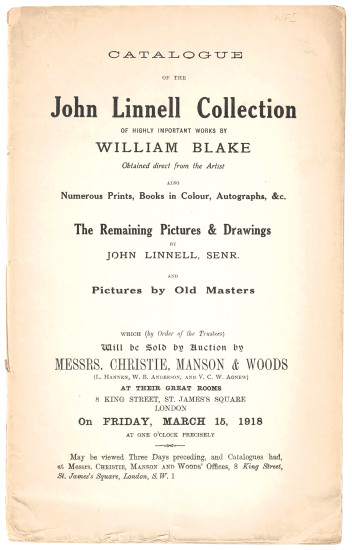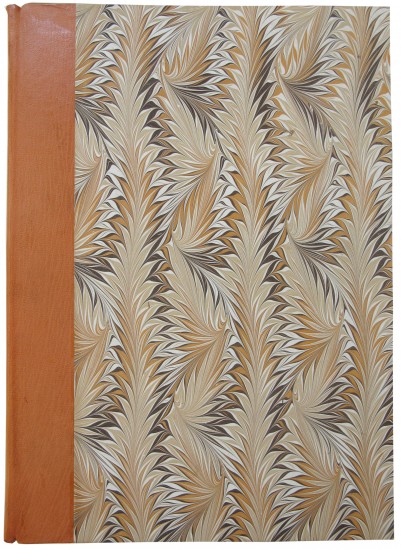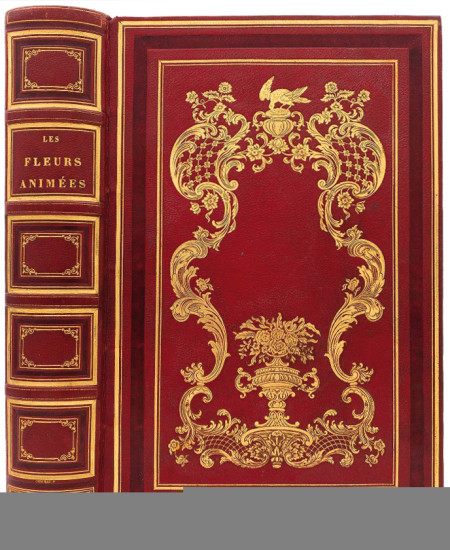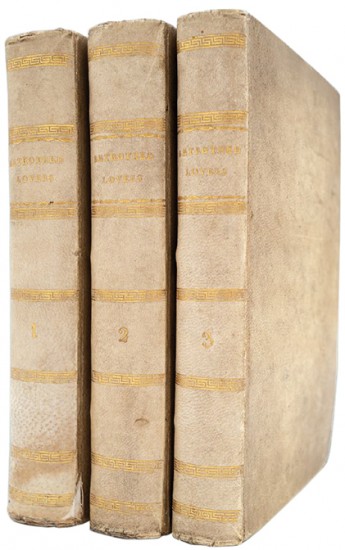The Marriage of Heaven and Hell
Blake, William
(London). (John Camden Hotten). 1868
The first published facsimile of any of William Blake's illuminated books, John Camden Hotten's 'The Marriage of Heaven and Hell'.
From the edition limited to 150 (possibly 153) copies.
This facsimile, made c.1868 and the first of any of William Blake's illuminated books, features lithograph text and illustration with the colour provided in watercolour by hand. Blake's original work, printed using copper engraving for the text and outlines and then finished by hand, was produced c.1790 - 1793 and is extant in only nine complete copies, each unique, and some fragments. This facsimile was produced by using copy 'F', dated by scholars to c.1795, now held by New York's The Morgan Library & Museum. At the time the facsimile was produced the original was in the collection of Richard Monckton Milnes, Baron Houghton (1809 - 1885) and as per 'Blake Books', Houghton lent it to the publisher John Camden Hotten for reproduction. A note in the supplement volume to 'Blake Books', taken from Sir Geoffrey Keynes' copy of his 'Bibliography' (1921) - now in Cambridge University Library - suggests otherwise: 'Edward Gordon Duff told John Sampson that Lord Houghton lent his copy of the original to Swinburne, and that Camden Hotten made his facsimile [1868] without permission, whereat Lord Houghton was much incensed.'
The publisher John Camden Hotten was the first to publish a critical study of Blake (Swinburne's 'William Blake: A Critical Essay', 1868) that included too the first colour reproductions of works by Blake. For the 'The Marriage of Heaven and Hell' facsimile, planned as the first of many, he made use of the skill of the artist Henry Bellars, described by H. Spencer Ashbee as 'perhaps the best facsimilist that ever lived' who likely made use of a photographic process to transfer the text and image to the stone (see Morton Paley's extensive exegesis for fuller details). Hotten's project to issue further facsimiles was curtailed by Bellars death in the year this was issued.
All copies of this 1868 facsimile, printed on a thick wove stock chosen for its similarity to Blake's original paper, feature spotting, foxing and staining - a result of the reaction between the printing ink, the hand-applied watercolour and the paper - as well as some oxidisation of the inks used; the present example features foxing and staining as usual, although largely marginal, but the colour remains bright and fresh and comparable to that of the original book.
'For every thing that lives is Holy'. (William Blake).
'Some time during the first months of 1790 a devil spoke to William Blake, an alter ego who revealed a truth and with whom a marriage was conceived, leaving neither the devil nor Blake the same again. The child of this union was 'The Marriage of Heaven and Hell' ... It is a work that deliberately unsettles and questions, prods and cajoles, challenging the way we think. It tells us that evil is good and good evil, and promises us a Bible of Hell. The 'Proverbs of Hell' have become a lexicon of protest and liberation, upsetting convention and subverting authority, made all the more memorable by the spirit of exuberant delight that characterizes their collective wisdom.' (MichaelPhillips).
[Blake Books I, 99, see also 98, pp. 285- 304 & Supplement 98, pp. 97 - 101; Keynes 210; Bentley & Nurmi 85; see Morton D. Paley's 'John Camden Hotten, A. C. Swinburne, and the Blake Facsimiles of 1868', Bulletin of the New York Public Library, Vol. 79, 1975 - 1976; see also Bodleian facsimile, 2011].
From the edition limited to 150 (possibly 153) copies.
This facsimile, made c.1868 and the first of any of William Blake's illuminated books, features lithograph text and illustration with the colour provided in watercolour by hand. Blake's original work, printed using copper engraving for the text and outlines and then finished by hand, was produced c.1790 - 1793 and is extant in only nine complete copies, each unique, and some fragments. This facsimile was produced by using copy 'F', dated by scholars to c.1795, now held by New York's The Morgan Library & Museum. At the time the facsimile was produced the original was in the collection of Richard Monckton Milnes, Baron Houghton (1809 - 1885) and as per 'Blake Books', Houghton lent it to the publisher John Camden Hotten for reproduction. A note in the supplement volume to 'Blake Books', taken from Sir Geoffrey Keynes' copy of his 'Bibliography' (1921) - now in Cambridge University Library - suggests otherwise: 'Edward Gordon Duff told John Sampson that Lord Houghton lent his copy of the original to Swinburne, and that Camden Hotten made his facsimile [1868] without permission, whereat Lord Houghton was much incensed.'
The publisher John Camden Hotten was the first to publish a critical study of Blake (Swinburne's 'William Blake: A Critical Essay', 1868) that included too the first colour reproductions of works by Blake. For the 'The Marriage of Heaven and Hell' facsimile, planned as the first of many, he made use of the skill of the artist Henry Bellars, described by H. Spencer Ashbee as 'perhaps the best facsimilist that ever lived' who likely made use of a photographic process to transfer the text and image to the stone (see Morton Paley's extensive exegesis for fuller details). Hotten's project to issue further facsimiles was curtailed by Bellars death in the year this was issued.
All copies of this 1868 facsimile, printed on a thick wove stock chosen for its similarity to Blake's original paper, feature spotting, foxing and staining - a result of the reaction between the printing ink, the hand-applied watercolour and the paper - as well as some oxidisation of the inks used; the present example features foxing and staining as usual, although largely marginal, but the colour remains bright and fresh and comparable to that of the original book.
'For every thing that lives is Holy'. (William Blake).
'Some time during the first months of 1790 a devil spoke to William Blake, an alter ego who revealed a truth and with whom a marriage was conceived, leaving neither the devil nor Blake the same again. The child of this union was 'The Marriage of Heaven and Hell' ... It is a work that deliberately unsettles and questions, prods and cajoles, challenging the way we think. It tells us that evil is good and good evil, and promises us a Bible of Hell. The 'Proverbs of Hell' have become a lexicon of protest and liberation, upsetting convention and subverting authority, made all the more memorable by the spirit of exuberant delight that characterizes their collective wisdom.' (MichaelPhillips).
[Blake Books I, 99, see also 98, pp. 285- 304 & Supplement 98, pp. 97 - 101; Keynes 210; Bentley & Nurmi 85; see Morton D. Paley's 'John Camden Hotten, A. C. Swinburne, and the Blake Facsimiles of 1868', Bulletin of the New York Public Library, Vol. 79, 1975 - 1976; see also Bodleian facsimile, 2011].
[27 leaves]. 4to. (251 x 200 mm). Leaf with pictorial lithograph title and 26 leaves of thick wove paper with lithograph text and illustration, all after William Blake by Henry Bellars and all with additional colouring and heightening in watercolour by hand. Original publisher's vellum-backed blue paper-covered boards.
#48346











